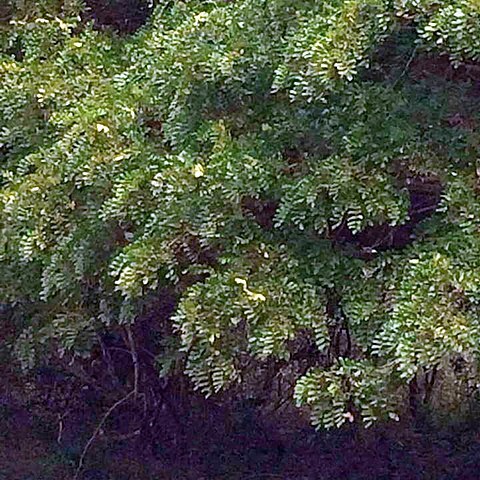A tree. It grows 6-15 m tall. It has a spreading crown and a straight stem when grown in open places. It can have several stems. The stems are white mottled with grey. The leaves are carried one after another along opposite sides of the branch. They are 15 cm long with 3-6 pairs of leaflets and one at the end. The leaflets are 1-2 cm long and about 1.9 cm wide with unequal sides. The leaves have slender stalks and the leaflets do not have stalks. The leaves turn yellow before they fall off. The buds are round, brown and hairy. They are carried in the axils of leaves. The flowers are small and green and have a scent. The fruit are oval and 2.5 cm long. They are reddish-brown and velvety with a crisp shell. Inside is a thin layer of red flesh which tastes like dried apricots. The seeds are small, shiny and irregular in shape. The fruit are edible.
Leaves: petiole and rachis together (3)5–9(14) cm long, puberulous; leaflets (7)9–11(13), alternate or the lower opposite, or occasionally all opposite except the terminal one, 1–3.5(4.3) × 0.7–2 cm, the lower ones broadly ovate and rounded at the base, the upper ones elliptic and cuneate at the base, asymmetric at the base, broadly rounded or rarely slightly acuminate at the apex, glabrous or with a few hairs on the midrib beneath; petiolule 1–2 mm long, puberulous.
Seeds 1 or 2, brown, shiny, 8–9 × 3.5–5 mm and ± lenticular when only one developing, c.8 × 5 × 4 mm and elongate with ± triangular cross-section when two per fruit.
Fruits 1.2–2 × 1–1.5 cm, slightly elongate, smoothly rounded at apex with style base not showing, densely dark brown-puberulous to-tomentellous.
Buds and sepals up to 3–3.5 mm long, densely covered in appressed brown hairs outside; sepals white or cream or yellowish-green inside.
Flowers 6–8 mm across, in panicles up to 25 × 20 cm; inflorescence axes puberulous to appressed pubescent; pedicels 1–3 mm.
Petals 0, or rarely two sepal-like structures present in addition to the five sepals in some flowers.
Ovary c.1 mm long, brown tomentose; style 2–3 mm, glabrous or with a few hairs towards the base.
Stamens 6–10; anthers 1–1.5 mm long; filaments 1.5–2.5 mm long.
Tree 5–10 m high; bark smooth, ± grey.
Young branches minutely puberulous.


